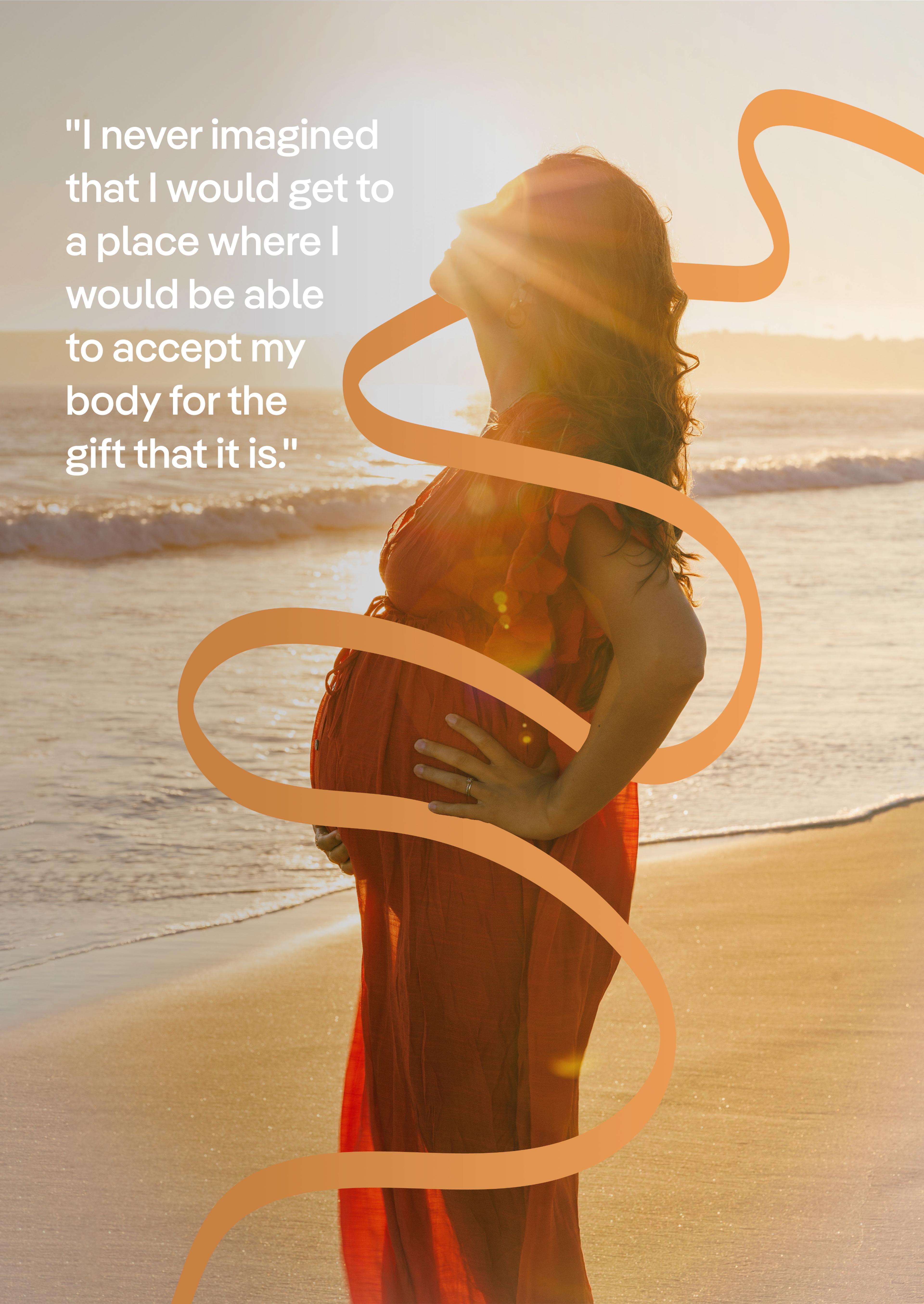


When it came time to write my master’s thesis on health disparities, I had zero hesitation choosing the topic. I’d recently seen renowned eating disorder researcher Cynthia Bulik, Ph.D. on a morning news show, detailing her latest research on midlife eating disorders. Bulik and her colleagues had surveyed 1,849 participants and found that not only do a significant number of women over 50 express weight and shape concerns, but that about 13 percent of them exhibit eating disorder symptoms. This was a seriously groundbreaking revelation, especially because it debunked the pervasive myth that eating disorders almost exclusively affect teens and adolescents.
In my research for the project, which was ultimately published in Oprah Magazine, I spoke with a number of women who had either experienced eating disorders at a young age and relapsed in midlife, or who had developed disorders for the first time in their 40s, 50s, and later. One woman told me that when her husband abruptly left her at 41 years-old, she quickly fell back into a calorie-counting obsession that had given her a sense of control and stability in her teens. “One of my closest friends said, 'Gosh, you'd think at 50 you wouldn't be worried about your weight,'" she told me. "I couldn't stand that feeling of stigma."
Another woman told me that her attempts to reclaim her “pre-baby body” as a mother of four in her 40s developed into bulimia, which later morphed into anorexia when her 16-year-old daughter began to grow distant. One day, she was so undernourished that she blacked out while driving her daughter to the mall. "It's ironic because when I was close to my lowest weight, my doctor congratulated me on how wonderful I looked," she said.
I heard many stories like these from many women over the course of my reporting, bringing Bulik’s research to life. And while my story and Bulik’s research focused specifically on women, midlife eating disorders can and do affect people of any gender. Yet eating disorders beyond young adulthood are still woefully ignored in larger conversations around disordered eating, and far too many people aren’t getting the care they deserve to fully recover. Understanding the causes, symptoms, and treatment options for midlife eating disorders may help more people recognize that eating disorders don’t discriminate, and anyone of any age deserves the support they need to recover.
How common are eating disorders in midlife?
According to Bulik’s original research, about 13 percent of women over 50 exhibit eating disorder symptoms. However, this doesn’t account for people of other genders who may struggle with disordered eating, nor does it encompass those who may experience eating disorder symptoms at other points in adulthood (for instance, someone in their mid-forties).
“For the first half of my career as an eating disorder specialist, I worked very often with folks who were experiencing midlife eating disorders,” says Equip Lead Therapist and Clinical Supervisor, Brittney Lauro, LCSW. “Some had experienced a relapse after certain life events, others had a multi-decade battle with the eating disorder and never had quite reached full recovery, and some had a new onset of an eating disorder—usually in their 30s and 40s—that persisted.”
A 2023 review found that between 2.1 and 7.7% of midlife women are diagnosed with an eating disorder, and less than 1% of midlife men are diagnosed. The review also found that while the prevalence of eating disorders decreases with age in women, it “does not get towards zero even in very high age.” Additionally, women who reported severe menopausal symptoms showed more eating disorder pathology compared with those with less severe menopausal symptoms; hormonal disturbances may also occur in midlife men experiencing eating disorders.

What causes eating disorders in midlife?
In many ways, eating disorders that develop in midlife are distinct from eating disorders that develop at younger ages, but one similarity is that—regardless of age of onset—there’s almost never one single cause. Rather, eating disorders emerge out of a variety of biological, genetic, psychological, and environmental factors.
Bulik identified three distinct groups of women with midlife eating disorders:
- Those who had developed disorders in adolescence, recovered, and then relapsed
- Those who developed eating disorders at a younger age and never fully recovered
- Those who developed an eating disorder for the first time later in life
No matter which of the three buckets a person falls into, there are a number of common factors that can contribute to the development (or worsening) of an eating disorder in midlife. “Like with eating disorders in all ages, major changes in life circumstances—whether social, emotional, or physical—can prompt an eating disorder,” Lauro says. “When thinking about midlife, menopause and perimenopause can absolutely be a prompting event due to the significant hormonal changes. Other prompting events could be children moving out, losing a loved one, being diagnosed with a serious illness, divorce, or retirement.”
Lauro has also found that while most people face body image struggles, due in part to media images and social pressures, those in midlife often encounter a distinct challenge related to the aging process: namely, seeing their body shape and size change in ways they may not like. “Another interesting finding that I’ve observed in my career and I believe is currently being published is the fact that folks in midlife are more likely to compare themselves to a younger version of themself, as opposed to media images,” Lauro says. “That doesn’t mean that media images don’t have an impact at all, they certainly do, but in midlife we tend to see a lot of self-comparison.”
Are certain types of eating disorders more common in midlife?
It’s possible for a person to develop any type of eating disorder later in life, and research is torn about whether or not some diagnoses are more common than others. According to the 2023 review mentioned above, OSFED (other specified feeding or eating disorder) and BED (binge eating disorder) are the most prevalent diagnoses, while other research has indicated that atypical anorexia is the most prevalent diagnosis and binge eating is the most prevalent core eating disorder symptom.
“In my experience, there were equal amounts of folks coming in with anorexia, bulimia, OSFED, and BED,” Lauro says. “I was less likely to see ARFID, however that may be due to the fact that ARFID is a relatively newly recognized diagnosis, and so folks may not be aware of it.” (There’s also a common misconception that ARFID only affects kids—that’s not true.)
Lauro adds that many people struggling with midlife eating disorders assume their own diagnosis to be BED, when it’s in fact a different type of eating disorder. “I do see a majority of folks self-reporting BED when they first come in,” she says. “However, upon clinical assessment, bulimia, OSFED, or sometimes anorexia is actually a better explanation. I think this is in part because of the fact that we are immersed in diet culture in our society, which puts a big emphasis on demonizing binge eating.”
Another diagnosis that Lauro often observes in midlife clients is not yet recognized by the DSM: orthorexia, or an obsession with “clean eating.” “If I were to hypothesize why this diagnosis impacts folks in midlife, I’d say it could be in part due to a hope that eating a certain way will restore health, or restore youth,” she says. “Making adjustments to eating isn’t a problem in and of itself, however when it turns into multiple food groups being eliminated—outside of acute medical necessity—it becomes a problem.”
Mental and physical health risks of eating disorders in midlife
Eating disorders at any age can contribute to a long list of physical and psychological consequences, ranging from thinning bones and slow pulse to brain damage, organ failure, and even death. These illnesses are damaging and potentially fatal at any age, but some of the resulting issues—including heart and lung problems, bone loss, gastrointestinal symptoms, diabetes, and skin breakdown—can be particularly dangerous for those in midlife.
“In addition to typical eating disorder risks like worsening anxiety or depression, brittle bone disease, cardiovascular implications, and issues related to gastric motility and gut health, eating disorders in midlife can further exacerbate other medical and mental health conditions,” Lauro says. “Perimenopause can also interact with eating disorders due to the substantial shift in hormones. Both perimenopause and eating disorders can have a profound impact on mood and level of functioning.”

How are midlife eating disorders treated?
While there are several different types of evidence-based treatment for eating disorders, Lauro says enhanced cognitive behavioral therapy (CBT-E) can be a particularly effective approach for older adults. “When thinking about eating disorders in midlife, I’ve found the most success in working with individuals using CBT-E,” she says. “I cannot emphasize enough that when implemented correctly, CBT-E is vastly different from regular CBT or even prior adaptations of CBT for eating disorders.”
Specifically designed to treat eating disorders, CBT-E is unique in its modular integration of strategies and procedures that allow it to be both flexible and individualized. “CBT-E differs from some of the front-line treatments for adolescents in that the adult has more autonomy and is essentially in the driver’s seat in their own recovery and what they want recovery to look like for them,” Lauro says. The treatment is typically divided into four stages that revolve around personalized education, progress monitoring, patient-specific sessions, and planning ahead for the future.
“What I find most effective when implementing CBT-E is the motivational interviewing component,” Lauro says. “One strength in midlife is that your brain is fully developed—with the exception of atrophy that comes with severe malnutrition—and this allows folks to be more engaged in the process. We essentially draw a ‘road map’ of how the eating disorder works for the individual specifically, and then use that as our guide throughout treatment.”
While CBT-E may be the most appropriate treatment option for most people in midlife, Lauro says that for some with a long history of an eating disorder—particularly severe and enduring anorexia— an FBT (family-based treatment) approach may be best. “I’ve worked with a number of adults in midlife who have had substantial histories of eating disorders, and I’ve seen them make amazing strides when they are able to access an FBT-style approach and are surrounded by supports who hold loving but firm boundaries,” Lauro says. “In these situations, it truly takes a village. It can feel unconventional at times due to the person being an adult, but I’ve seen this approach be a game changer for folks. Hope is not lost based on age.”
What are some of the barriers to treating eating disorders in midlife?
Unfortunately, people of all ages face barriers to effective eating disorder treatment, be they financial, logistical, geographical, cultural, or otherwise. However, those in midlife might come up against specific roadblocks.
“There are a variety of barriers when it comes to those in midlife accessing eating disorder treatment,” Lauro says. “Most often, I see it being related to financial challenges and responsibilities. Many folks struggle with finding treatment covered by insurance. And often, if intensive treatment is needed, people have more limited ability to take family and medical leave. Even with family and medical leave, this can lead to major financial burdens that aren’t sustainable for some families and individuals.”
Societal pressures, expectations, and stereotypes around what it means to be in midlife and what it “looks like” to have an eating disorder can also keep people from getting the care they need. In other words, someone in midlife may hesitate to seek help because they don’t fit the mold of the “typical” eating disorder patient (spoiler alert: that patient doesn’t exist), feel shameful about struggling with something that they don’t think they should be, or believe they’re “not sick enough” to need help.
“Second to financial and responsibility burdens, I often see stigma and beliefs like, ‘I’ve been this way most of my life, I must not have a problem,’” Lauro says. “Even in 2024, there is still such little information and education available on eating disorders. When I think of folks currently in the midlife range, I think about how in years past, there was even less information available. So many disordered eating habits are praised as healthy and idealistic in our society.”
While eating disorder education and awareness has become more widespread over recent years, it’s also important to understand that even medical professionals are still learning to adequately and sensitively receive patients who present with eating disorder concerns or symptoms, and this can be particularly true for older patients. “The lack of knowledge and education historically also impacts providers in the field, many of whom don’t receive training on eating disorders,” Lauro says. “There’s a saying: ‘we don’t know what we don’t know’ and unfortunately, this lack of education results in mounting barriers and missed opportunities for treatment.”
Despite the roadblocks and challenges that may prevent those in midlifes from receiving proper care, there are many reasons to believe people of all ages can achieve full, lasting eating disorder recovery. “There is so much hope for people seeking eating disorder treatment in midlife,” Lauro says. “I have seen firsthand folks making tremendous strides. I’ve seen folks with 30, 40+ year histories of eating disorders reach a point of stability. I’ve seen folks with a new onset of eating disorder in midlife reach recovery. It is never too late to get treatment. Aside from the improvements in health status and longevity, folks who receive treatment for eating disorders in midlife often tell me what a positive impact it has had on their relationship with their family, friends, and loved ones.”
If you’re struggling with a midlife eating disorder, or are concerned about a loved one, don’t wait any longer to get help. Schedule a free, no-obligation consultation with our team.
- Brown, Tiffany A., K. Jean Forney, Kelly M. Klein, Charlotte Grillot, and Pamela K. Keel. 2020. “A 30-Year Longitudinal Study of Body Weight, Dieting, and Eating Pathology across Women and Men from Late Adolescence to Later Midlife.” Journal of Abnormal Psychology 129 (4): 376–86. https://doi.org/10.1037/abn0000519.
- Gagne, Danielle A., Ann Von Holle, Kimberly A. Brownley, Cristin D. Runfola, Sara Hofmeier, Kateland E. Branch, and Cynthia M. Bulik. 2012. “Eating Disorder Symptoms and Weight and Shape Concerns in a Large Web-Based Convenience Sample of Women Ages 50 and Above: Results of the Gender and Body Image (GABI) Study.” The International Journal of Eating Disorders 45 (7): 832–44. https://doi.org/10.1002/eat.22030.
- Konstantinovsky, Michelle. 2013. “Adult Eating Disorders - Adult Women with Anorexia.” Oprah.com. Oprah.com. May 2, 2013. https://www.oprah.com/health/adult-eating-disorders-adult-women-with-anorexia.
- Mangweth-Matzek, Barbara, Claudia Ines Rupp, Sophia Vedova, Vanessa Dunst, Philine Hennecke, Martin Daniaux, and Harrison G. Pope. 2021. “Disorders of Eating and Body Image during the Menopausal Transition: Associations with Menopausal Stage and with Menopausal Symptomatology.” Eating and Weight Disorders - Studies on Anorexia, Bulimia and Obesity, February. https://doi.org/10.1007/s40519-021-01141-4.
- Mangweth-Matzek, Barbara, Kai K. Kummer, and Hans W. Hoek. 2023. “Update on the Epidemiology and Treatment of Eating Disorders among Older People.” Current Opinion in Psychiatry 36 (6): 405–11. https://doi.org/10.1097/YCO.0000000000000893.
- National Institute of Mental Health. 2021. “Eating Disorders: About More than Food.” National Institute of Mental Health. 2021. https://www.nimh.nih.gov/health/publications/eating-disorders.
- “Overview of Treatment Barriers - Project HEAL.” n.d. ProjectHEAL. https://www.theprojectheal.org/overview-of-treatment-barriers.
- Salamon, Maureen. 2022. “Eating Disorders in Midlife.” Harvard Health. December 1, 2022. https://www.health.harvard.edu/womens-health/eating-disorders-in-midlife.







